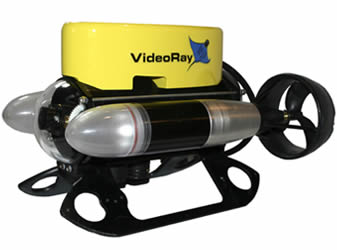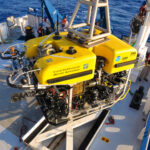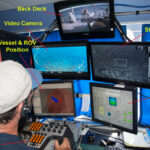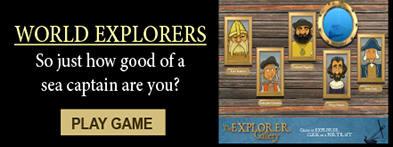ROV
Tool
Modern
Quick Facts:
Controlled by a crew aboard a vessel on the surface, ROVs can explore and work in the deepest parts of the ocean.
Introduction
ROVs are very useful tools that help conduct a wide range of underwater tasks. They have helped scientists solved some of the most puzzling and dangerous tasks in the deep-sea. They are able to travel to some of the deepest, darkest areas of the oceans to help us better understand life down there. Because of this, they have become a valuable addition to the world of deep-sea exploration.
History
ROV stands for Remotely Operated Vehicle. Many deep-water environments are too harsh for humans to directly work in. ROVs are often used to locate and document sites in deep-water where divers cannot reach. The first fully developed ROV, POODLE, was created by Dimitri Rebikoff in 1953. However, it was not until the United States Navy took an interest in ROVs that the technology really took off. In 1961 the US Navy created the Cable-Controlled Underwater Research Vehicle (CURV). Even though CURV was used to recover lost sunken torpedoes, it paved the way for a brand new era in deep sea exploration. Following the success of CURV, the US Navy continued to make advancements in the ROV industry. In 1974 only 20 ROVs were available, and 17 of them were government owned. By the end of 1982, there were 500, many of which were commercially owned; and by 1998 there were more than 3000 ROVs worldwide.1
One of the best ways ROVs have been used in underwater exploration is in maritime archaeology. Deep-water archaeology are investigations in water depths that are not accessible by divers. In these situations, scientists often rely on ROVs.2 Marine archaeologists explore and study underwater sites like shipwrecks.3 The ROV Hercules was built for the Institute for Exploration (IFE). It was specifically designed to explore, study, and recover artifacts from ancient shipwrecks. Hercules was used by the National Oceanic and Atmospheric Administration (NOAA) in 2004 for an 11 day mapping and condition report of the Titanic wreck. It also supported an archaeological discovery in the Mediterranean sea. It helped locate and study the remains of different ancient maritime cultures.4
How It Works
ROVs are mobile robots designed for work in underwater environments.5 They come in a variety of sizes from small to large based on their use. A simple description of an ROV is a camera mounted in a waterproof enclosure; it uses thrusters to move around and is attached, or tethered, to a cable to the surface which sends a video signal.6 They usually have lights and cameras for taking videos and pictures. Many of them also have mechanical arms to lift, move, or grab objects. The tethered connection is what powers the ROV and allows the crew to control it from above the water. There are two classes of ROVs: the Observation-class, and the Work-class. The Observation-class ROV is better for taking pictures and recording video. The Work-class ROV is better equipped to deliver tools and perform more difficult task.7
Endnotes
- Robert D. Christ and Robert L. Wenli Sr., The ROV Manual: A User Guide for Observation-Class Remotely Operated Vehicles (Massachusetts: Butterworth-Heinemann, 2007), 5-6.
- Fredrik Soreide, Ships from the Depths: Deepwater Archaeology (College Station: Texas A&M University Press, 2011), 6.
- Soreide, Ships from the Depths, 6.
- “Hercules (ROV) and Friends,” National Oceanic and Atmospheric Administration, Accessed August 14, 2017, http://oceanexplorer.noaa.gov/technology/subs/hercules/hercules.html.
- “Underwater ROV (Underwater Remotely Operated Vehicle),” Tech Target, Accessed August 14, 2017, http://whatis.techtarget.com/definition/underwater-ROV-underwater-remotely-operated-vehicle.
- Christ and Wenli, Sr.,The ROV Manual, 2.
- Soreide, Ships from the Depths,13-17.
Bibliography
Christ, D. Robert and Robert L. Wenli, Sr. The ROV Manual: A User Guide for Observation-Class Remotely Operated Vehicles. Massachusetts: Butterworth-Heinemann, 2007.
National Oceanic and Atmospheric Administration. “Hercules (ROV) and Friends.”Accessed August 14, 2017. http://oceanexplorer.noaa.gov/technology/subs/hercules/hercules.html.
Soreide, Frederik. Ships from the Depths: Deepwater Archaeology. College Station: Texas A&M University Press, 2011.
Tech Target. “Underwater ROV (Underwater Remotely Operated Vehicle).” Accessed August 14, 2017. http://whatis.techtarget.com/definition/underwater-ROV-underwater-remotely-operated-vehicle.
Gallery
- ROV “Hercules” (Credit: NOAA)
- ROV Diagram sample (Credit: National Ocean Service)
- ROV Crew Operations (Credit: National Ocean Service)
- ROV “Mohawk” (Credit: National Ocean Service)







